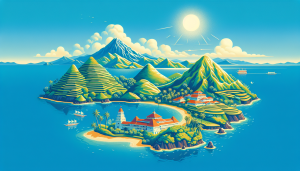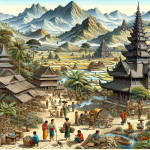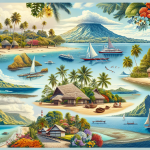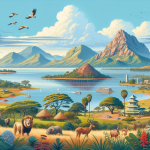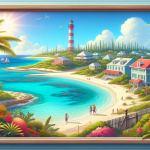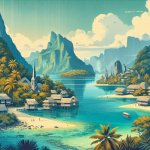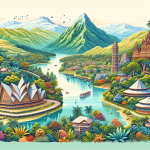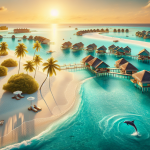Exploring the Philippines: A Tropical Paradise Awaiting Your Adventure
The Philippines, an archipelago of more than 7,000 islands, is a tropical paradise that offers a unique blend of natural wonders, rich culture, and warm hospitality. This Southeast Asian nation is famous for its stunning beaches, crystal-clear waters, vibrant cities, and lush mountain landscapes. Whether you are a seasoned traveler or a first-time visitor, the Philippines captivates and inspires. This comprehensive guide delves into the beauty and charm of the Philippines, highlighting its must-visit destinations, cultural experiences, and practical travel tips to ensure your journey is unforgettable. From the bustling streets of Manila to the serene shores of Palawan, the Philippines is a destination that promises adventure, relaxation, and discovery. So pack your bags, grab your camera, and get ready to explore a country that is as diverse as it is beautiful. Join us as we embark on a journey through the Philippines, uncovering its hidden gems and popular attractions that make it one of the most enchanting travel destinations in the world.
The Natural Wonders of the Philippines
The Pristine Beaches of Palawan
Palawan is often hailed as the crown jewel of the Philippines, and for a good reason. This island province boasts some of the most beautiful beaches in the world, with El Nido and Coron being the standout destinations. El Nido is renowned for its dramatic limestone cliffs, crystal-clear lagoons, and diverse marine life, making it a haven for divers and snorkelers. Coron, on the other hand, is famous for its stunning underwater landscapes, including World War II shipwrecks that attract diving enthusiasts from around the globe. The powdery white sands, turquoise waters, and lush greenery of Palawan create a postcard-perfect setting that feels like a slice of paradise.
The Majestic Chocolate Hills of Bohol
Bohol, an island province in the central Visayas region, is home to the Chocolate Hills, one of the Philippines’ most iconic natural landmarks. These unique geological formations consist of over 1,200 conical hills that turn brown during the dry season, resembling chocolate mounds. The hills are best viewed from the Chocolate Hills Complex, where visitors can enjoy panoramic views of this surreal landscape. Bohol is also home to the Philippine tarsier, one of the world’s smallest primates, which can be observed at the Tarsier Sanctuary.
The Enchanting Underground River of Puerto Princesa
The Puerto Princesa Subterranean River National Park, a UNESCO World Heritage Site, is a must-visit destination in the Philippines. This natural wonder features an 8.2-kilometer-long underground river that winds through a limestone cave system before emptying into the West Philippine Sea. Visitors can take guided boat tours through the underground river, marveling at the impressive stalactites and stalagmites while learning about the cave’s fascinating ecosystem. The park is also home to diverse flora and fauna, making it a haven for nature enthusiasts.
Rich Cultural Experiences
The Vibrant Festivals of the Philippines
The Philippines is known for its lively and colorful festivals, which reflect the country’s rich cultural heritage and deep-rooted traditions. One of the most famous festivals is the Sinulog Festival in Cebu, held every January in honor of the Santo Niño (the Holy Child). The festival features a grand street parade with participants dressed in vibrant costumes, dancing to the rhythmic beat of drums and native instruments. Another notable festival is the Ati-Atihan Festival in Kalibo, Aklan, which also celebrates the Santo Niño and features street dancing, music, and elaborate costumes.
The Historic Walled City of Intramuros
Intramuros, the historic walled city in Manila, offers a glimpse into the Philippines’ colonial past. Built by the Spanish in the late 16th century, Intramuros served as the political and military center of the Philippines during the Spanish colonial period. Today, visitors can explore the well-preserved walls, gates, and bastions, as well as historic sites such as Fort Santiago, San Agustin Church, and Casa Manila. A walk through Intramuros is like stepping back in time, with its cobblestone streets, colonial architecture, and horse-drawn carriages.
The Indigenous Cultures of the Cordillera
The Cordillera region in northern Luzon is home to several indigenous communities, each with its own unique customs and traditions. The Ifugao people, known for their intricate rice terraces, are one of the most prominent indigenous groups in the region. The Banaue Rice Terraces, often referred to as the “Eighth Wonder of the World,” are a testament to the Ifugao’s ingenuity and skill in creating sustainable agricultural landscapes. Visitors to the Cordillera region can immerse themselves in the local culture by participating in traditional rituals, visiting indigenous villages, and learning about the region’s rich history.
Adventure Activities
Diving and Snorkeling in the Philippines
With its diverse marine ecosystems and clear waters, the Philippines is a premier destination for diving and snorkeling enthusiasts. The Tubbataha Reefs Natural Park, a UNESCO World Heritage Site, is one of the best diving spots in the country. Located in the Sulu Sea, Tubbataha is home to a vast array of marine life, including colorful coral reefs, reef sharks, and sea turtles. Another popular diving destination is Apo Island in Negros Oriental, known for its vibrant coral gardens and abundant marine biodiversity.
Hiking and Trekking in the Philippines
For those who prefer land-based adventures, the Philippines offers a variety of hiking and trekking opportunities. Mount Pulag, the highest peak in Luzon, is a favorite among hikers for its stunning views and diverse flora and fauna. The trek to the summit takes you through mossy forests, grasslands, and dwarf bamboo groves, culminating in a breathtaking sunrise view above the clouds. Another notable trekking destination is Mount Apo, the highest mountain in the Philippines, located in Mindanao. The challenging ascent to Mount Apo’s summit rewards climbers with panoramic views of the surrounding landscapes and a sense of accomplishment.
Practical Travel Tips for the Philippines
Best Time to Visit
The Philippines has a tropical climate, with a dry season from November to April and a wet season from May to October. The best time to visit is during the dry season when the weather is generally sunny and ideal for outdoor activities. However, some regions, such as Bohol and Cebu, can be visited year-round due to their relatively mild and stable climate.
Getting Around
The Philippines’ archipelagic nature means that traveling between islands often requires a combination of flights, ferries, and land transportation. Domestic flights are the quickest way to travel between major islands, with airlines such as Cebu Pacific, Philippine Airlines, and AirAsia offering numerous routes. For shorter distances, ferries and boat rides are common modes of transport, with companies like 2GO Travel and OceanJet providing regular services. Within cities and towns, jeepneys, tricycles, and taxis are popular and affordable options for getting around.
Health and Safety
While the Philippines is generally a safe destination for travelers, it’s important to take standard precautions to ensure a smooth and enjoyable trip. Travel insurance is highly recommended to cover any unexpected medical expenses or travel disruptions. It’s also advisable to consult a healthcare professional before your trip to discuss any necessary vaccinations and health precautions. When exploring remote areas or engaging in outdoor activities, always stay hydrated, use sunscreen, and follow local guidelines and safety advice.
Conclusion
The Philippines is a destination that offers something for everyone, from stunning natural landscapes and vibrant cultural experiences to thrilling adventure activities and warm hospitality. Whether you’re lounging on the pristine beaches of Palawan, exploring the historic streets of Intramuros, or diving into the colorful underwater world of Tubbataha, the Philippines promises an unforgettable journey filled with discovery and wonder. With its rich history, diverse culture, and breathtaking scenery, the Philippines is a tropical paradise that beckons travelers to explore and experience its many treasures. So why wait? Start planning your trip to the Philippines today and embark on an adventure of a lifetime.
For more information and travel inspiration, visit the Official Philippines Tourism Website.
